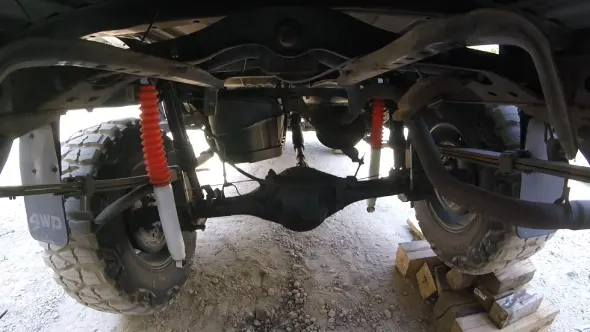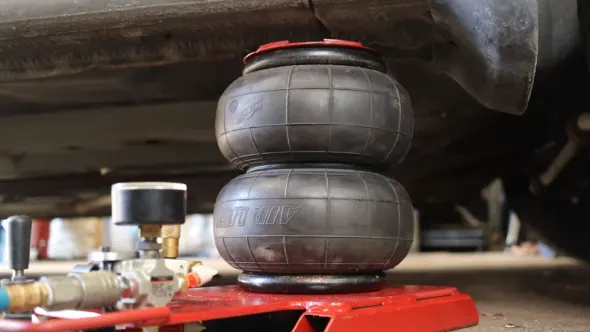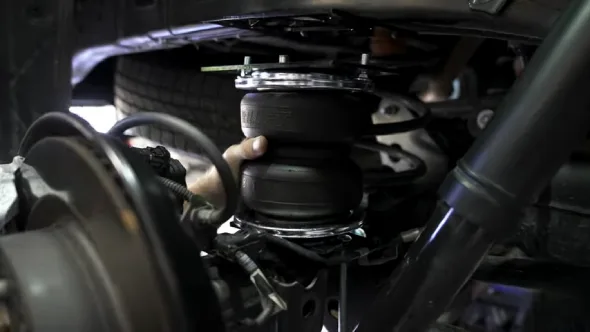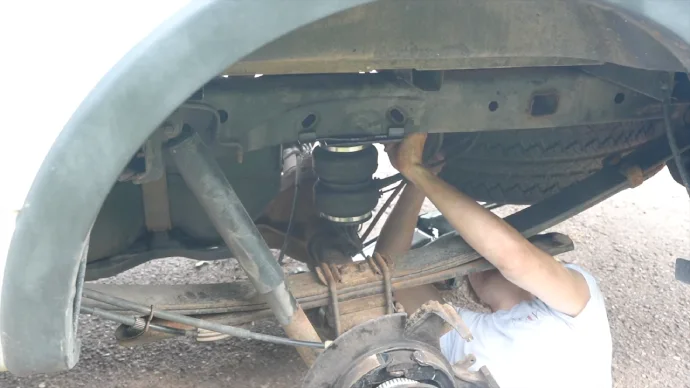Last Updated on March 20, 2023
For any vehicle owner considering lifting their truck, there are many factors to consider, and one point of confusion may be whether air shocks can be used to lift the truck.
While air shocks can adjust a ride height due to their compressibility when working alongside other lift kits, they are not designed as a lift of any kind and cannot carry a substantial portion of the truck’s weight.
Further, these shocks are not intended to increase the vehicle’s height significantly, so attempting this method is likely futile.
But air shocks can play a crucial role in improving your ride quality. When traveling over uneven terrain, adjusting the ride height helps increase overall stability and reduce jarring impacts. We will discuss the risks of using air shocks on trucks and what to consider when using air shocks, so read on.
Can I Use Air Shocks to Lift My Truck: What are the Risks?

Lifting a truck with air shocks may provide the driver with improved ground clearance and handling, but it can also create a variety of risks that must be carefully considered. The following are some of the potential risks:
Overloading the Weight Capacity
When using air shocks to lift a truck, it is essential to ensure that the weight capacity is not exceeded. Doing so could cause damage to the frame or suspension, resulting in costly repairs or even compromising the structural integrity of the vehicle.
To prevent this from happening, it is essential to understand the manufacturer’s recommended weight limits for both loaded and unloaded trucks. Also, drivers should maintain proper tire inflation as this can affect how much weight can safely be carried on any axle.
Vehicle Handling Issues
Lifting your truck with air shocks also affects its center of gravity and, thus, its handling characteristics. Consequently, drivers must adjust their driving style when using air shocks for lifting purposes.
Using higher pressure settings to achieve greater height can lead to handling problems like increased body roll when cornering and reduced acceleration capabilities due to increased mechanical resistance.
But adjusting shock pressure correctly according to manufacturer recommendations may allow drivers to enjoy improved off-road performance without sacrificing on-road stability or comfort.
Brake System Issues
Using air shocks for weight-bearing purposes also requires additional attention towards brake systems as larger wheels may require different brakes than what would usually be found on a regular pickup truck.
For example, larger wheels may require heavier-duty brake calipers capable of providing extra stopping power that smaller calipers may lack.
Also, some modifications, such as aftermarket brake lines, may need replacing due to increased load ratings for larger brakes which necessitate thicker brake lines capable of containing higher pressures.
Driver Safety Concerns
The primary dangers of using air shocks are strictly related to safety considerations. There’s no telling what could happen if one fails unexpectedly since vehicles using such equipment would be operating outside normal parameters set forth by manufacturers about weight distribution & handling.
You should always use extra caution when driving a vehicle with such gear, regardless of your experience level or familiarity with similar setups elsewhere. Mechanical failure can have catastrophic consequences if it happens at an inconvenient time.
When Should You Use Air Shocks on a Lifted Truck?

Lifted trucks use air shocks to create a smoother ride and improve control. They can also help to decrease tire wear and reduce the chances of bottoming out in off-road situations.
Here are some times when air shocks should be used on a lifted truck:
To Improve Ride Quality
An air suspension system is a great choice for anyone who needs improved ride quality and a smooth ride on their lifted truck.
Air shocks provide better damping than hydraulic or mechanical systems, which absorb more bumps on uneven terrain and offer a much smoother ride. The adjustable shock pressure also allows you to customize the comfort level that best suits your driving needs.
For Adjustable Ride Height
The air shocks are ideal for those looking for an adjustable ride height in their lifted truck. Adjusting the pressure in the air shock can raise or lower your truck’s overall height until it reaches a comfortable setting.
This will allow you to tailor your vehicle’s look to your preferences and maximize its performance during off-roading or other activities such as hauling heavy loads.
To Increase Load-Carrying Capacity
A lifted truck equipped with air shocks has greater load-carrying capacity than one without since they allow for easier suspension adjustments depending on how heavy your load is at any given time.
This ensures that all four wheels remain firmly planted on the ground even under pressure, which helps minimize swaying when cornering and provides additional stability while driving off-road or over bumpy terrain with heavier payloads.
For Better Controlling
Air shocks also provide improved control when driving your lifted truck over any terrain, particularly off-road, to adjustable shock pressures and increased dampening capabilities, which help reduce body roll and improve overall handling.
Also, they’ll reduce tire wear due to less bouncing up and down and decreasing chances of bottoming out when going over large obstacles or deep ruts.
What to Remember When Using Air Shocks with a Truck?

Air shocks are a popular upgrade for vehicles looking for better handling and performance, but there are some important things to remember when using them with a truck.
Air Shocks Aren’t for Lifting Vehicles
Air shocks are designed to provide improved performance, handling, and safety rather than just lift the vehicle. While using them for more ground clearance may be tempting, this isn’t recommended as it can cause premature wear on the shocks and other components.
The design of an air shock also means that it won’t provide any extra support when you hit bumps or potholes. They will just compress further when compressed heavily. If you want to raise your ride height, look into suspension lifts instead.
Don’t Install Air Shocks on the Front Axle Alone
It is strongly recommended that you install four air shocks on a truck, two in the front and two in the rear, for them to function correctly. Installing only two at either end of the axle (front or rear) will cause uneven suspension loading, resulting in poor handling and decreased shock performance.
It is also important not to install different brands/models of air shocks together as this could lead to further discrepancies in terms of performance and longevity between them.
Don’t Support Full Vehicle Weight on Them
Air shocks generally aren’t designed to withstand full-weight loads constantly, so relying on them solely to keep your vehicle upright isn’t recommended. This is especially true if you have installed other modifications, such as lifted springs.
The suspension setup should always include these if you want reliable support while driving and parking your truck. Instead, use air pressure adjustments (if offered by your product) to fine-tune ride height according to changing terrain or load amounts carried in your vehicle bed or cab space.
Air Shocks Aren’t for Heavy Trucks
If you have a heavy-duty truck such as a 3/4-ton pickup, air shock kits usually won’t provide enough strength for safe operation and should be avoided entirely. Heavy-duty trucks require more specialized equipment that can handle heavier loads, such as solid steel coil springs or leaf spring suspensions.
Modifications like these will give you better control over how much weight each spring can carry and provide a far safer ride than would be possible with standard air shock kits alone.
How Much Weight Will Air Shocks Lift Off a Truck?

Air shocks for trucks can provide up to 1200 pounds of weight support on the rear axle. They are designed to be easily adjustable, allowing users to fine-tune their suspension for off-road driving or heavy hauling needs.
The weight lifted by air shocks is limited by the vehicle’s gross vehicle weight rating (GVWR). Combined with other suspension components, they provide an effective ride quality and improved handling over traditional leaf springs or rigid suspensions.
How Much Pressure Can Truck Air Shocks Hold?
Truck air shocks can hold up to 150 PSI of pressure but typically operate at around 100 PSI during normal use. This allows them to provide a firm yet comfortable ride while taking on rough terrain and heavy loads without bottoming out or sagging excessively.
Their strong air pressure also helps maintain the load distribution between each axle and wheel, ensuring even tire wear and enhancing traction control when traversing slippery surfaces.
Tips for Installing an Air Shock on Your Truck

Installing an air shock absorber on your truck is important to maintaining its suspension system. Knowing how to install the air shock properly will ensure that your truck operates at its best and is safe.
Don’t Rotate the Lift
When installing an air shock, you must avoid rotating the lift arm of the suspension system. Rotating the lift arm can cause the shock to become misaligned, creating a significant handling problem for your vehicle.
To prevent this from occurring, ensure you have correctly identified each side of the mounting bracket and then secure it with bolts before installing the air shock.
Mount Air Line Fitting Properly
It’s also important to properly mount the air line fitting when mounting an air shock on the truck. Ensure you align both ends of the fitting in their respective positions before tightening them down with a wrench.
When connecting two pieces of tubing, use a sealant or lubricant to ensure no leakages in your system. Also, add clamps to both sides if they are adjustable. This will help prevent any movement once everything is connected and tightened down.
Avoid Tire Wear & Handling Issues
When installing an air shock absorber on your truck, be aware that incorrect installation can lead to excessive tire wear and handling issues due to uneven weight distribution over time.
To prevent these issues from occurring, make sure all nuts and bolts are tight and check torque levels regularly to ensure proper weight distribution across all four tires. Also, check for leaks periodically, as improper sealing can lead to further problems.
Installing Air Line Fittings
Installing air line fittings is key when adding an air shock onto your truck’s suspension system. Start by attaching the tubing to the frame and then attach another piece from the front or back, depending on where you want it to other components like shock absorbers or brakes.
Then securely fasten each connection with clamps or lock nuts so they do not move around after being tightened down, and double-check connections for any leaks before inflating your system with pressurized air.
Avoid Over-Tightening Air-Fitting Nut
When attaching new fittings onto existing components such as shock absorbers or brakes, always avoid over-tighten them as they can break incorrectly. Instead, use a torque wrench set at appropriate levels for each nut/bolt combination when working with different materials and thread sizes.
Putting Air in the System
Filling your suspension system with air is essential to keep your vehicle running smoothly and safely. Most garages have the equipment to do this job properly, saving you from expensive repair bills due to misuse or incorrect installation procedures.
When filling up your suspension system with pressurized air, you should leave some slack in the pipeline so it can expand and contract as the temperature changes through the year but still keep enough tension, so it’s secure and in place without losing control.
Maximize Ride Comfort and Performance: Add Air Shock Absorbers for Your Truck
Using air shocks on your truck isn’t suitable for lifting it, but it offers ride comfort and performance benefits. Air shock absorbers are designed to be adjustable, allowing you to adjust the ride height without compromising vehicle stability or safety.
With careful selection and installation with other lifting kits, air shock absorbers can improve the overall quality of your daily drive. Ensuring you have the right components installed on your truck is essential for achieving a safe and comfortable driving experience that meets all your needs.
